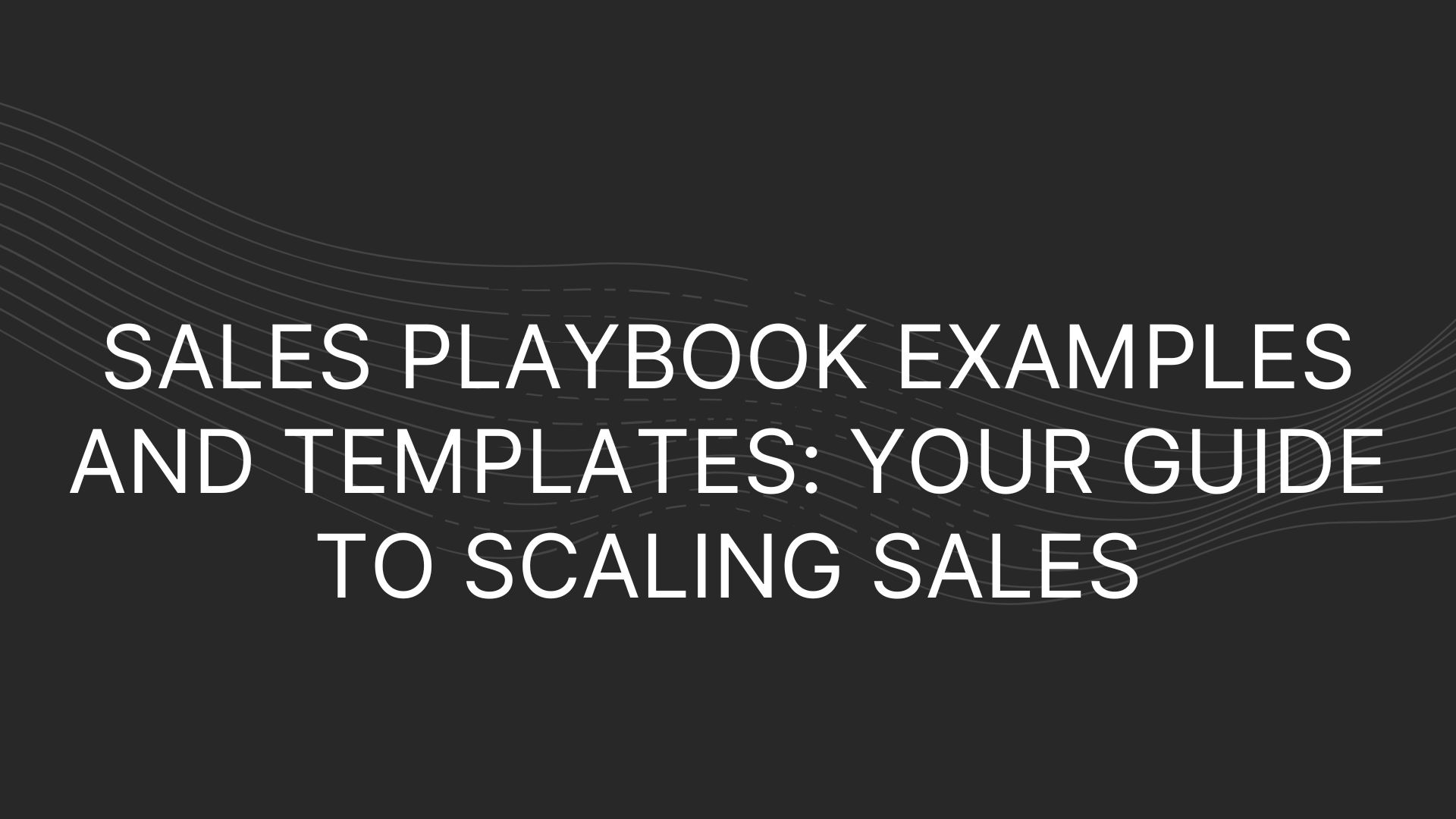Sales Playbook
A sales playbook is an essential framework outlining a business’s sales strategy. It encompasses a variety of tactics, modalities, and practices designed to align the sales team’s efforts with the company’s overarching goals. Sales playbooks typically include an overview of the company, as well as its mission, vision, and values, creating a comprehensive guide for sales reps.
Sales Strategies and Processes are clearly defined, providing salespeople with a clear path from prospecting to closing. It usually integrates the sales cycle or cycles pertinent to the industry and product line, ensuring that the team members understand each phase of the sales funnel.
Sales Plays: The playbook offers a collection of vetted sales plays, tailored for different scenarios within the sales process. These plays are informed by sales methodologies that have proven effective within the industry. These methodologies serve as the spine for sales enablement materials such as templates, tools, and resources.
Sales Goals and KPIs: Targets are set through sales goals and quotas, measuring performance against Key Performance Indicators (KPIs). These serve as benchmarks for sales reps and sales leaders to track progress and identify areas for improvement.
Development and Training: Onboarding and ongoing training material are vital for continually honing the skills of the sales team. Coaching guidelines are included to support the continual development of each salesperson.
Best Practices: Guidelines and best practices are interspersed throughout the playbook. These are gleaned from top-performers and tuned to meet the expectations of the sales leaders and the goals of the sales teams.
The sales playbook is a dynamic document, resonating with the company’s go-to-market strategy and providing the sales force with a structured approach to achieving sales excellence.
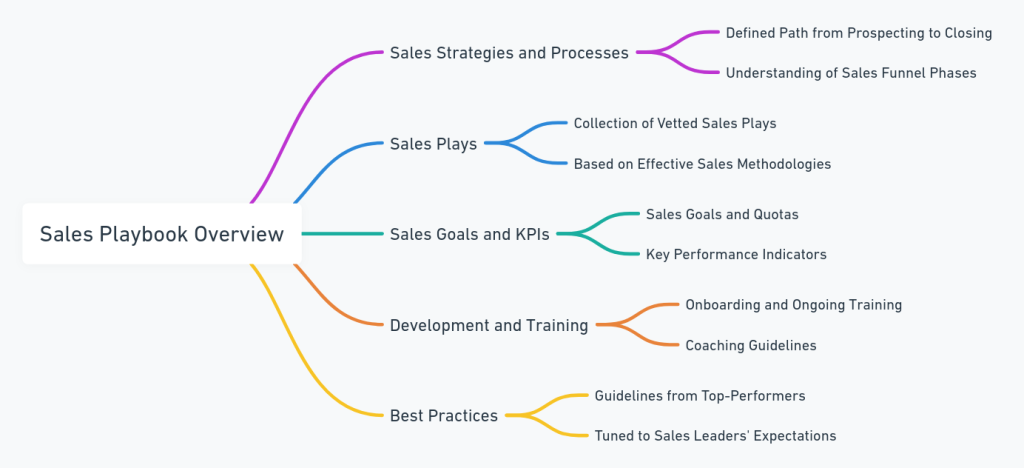
What Is a Sales Playbook?
A sales playbook is an essential document or digital resource that encapsulates the sales strategy, tactics, methods, and tools for an organization. Its purpose is to provide a comprehensive guide that sales teams can use to consistently and effectively close deals. It typically includes:
- Scripts: Tailored conversations for different sales scenarios.
- Buyer Personas: Detailed descriptions of ideal customers.
- Sales Processes: Step-by-step stages from initial contact to closing.
- Best Practices: Effective techniques and tips for selling.
By following a regimented sales playbook, the sales team can ensure they handle each prospect with an approach that’s been fine-tuned for success. It also aids in the onboarding of new sales representatives, as it provides them with a clear set of guidelines and procedures to follow.
Moreover, a well-crafted sales playbook covers:
- Common Objections: Pre-prepared responses to potential pushbacks from prospects.
- Tools and Technology: A list of software and tools to streamline the sales process.
- Key Performance Indicators (KPIs): Metrics to measure and track sales success.
The playbook equips sales professionals with the knowledge and resources to sell confidently and competently, addressing a multitude of situations with a standardized, yet flexible, approach.
Why Is a Sales Playbook Important?
A sales playbook is an essential component in a company’s sales process. It serves as a comprehensive guide for sales teams, encompassing various aspects of sales enablement and sales strategy. The playbook ensures consistency and clarity across the sales team, which can increase productivity and improve the performance of individual sales representatives.
One of the primary reasons a sales playbook is important is because it provides a detailed outline of the sales process. This includes best practices, strategies for handling objections, and tactics for competing against competitors. A well-crafted playbook empowers the sales team with the knowledge they need to engage prospects effectively.
Another key benefit of a sales playbook lies in its ability to accelerate onboarding for new sales representatives. The playbook acts as a training document that can reduce the time it takes for new hires to become productive, ensuring that they understand their role and how to approach sales in the context of the company’s overall strategy.
The sales playbook also assists in handling a variety of sales situations. By outlining scenarios and providing responses, the playbook enables the sales team to navigate conversations with confidence. It is particularly useful when dealing with complex sales cycles or when tailoring sales messages for different buyer personas.
Efficiency is another crucial aspect. Sales playbooks help in the reduction of time spent on creating sales materials by providing ready-to-use resources. This streamlines the selling process and allows sales teams to focus more on selling and less on administrative tasks.
A sales playbook is a valuable resource that contributes to a company’s successful sales ecosystem. It helps to establish a strong foundation for sales activities and supports the pursuit of business growth and market success.
Updating the Sales Playbook
A dynamic sales playbook is essential for maintaining an effective sales strategy. It must evolve to stay relevant in an ever-changing market. Regular revisions ensure that the playbook remains a reliable resource that can guide sales teams to success.
Key Steps for Updating:
- Collect Feedback: Sales representatives should provide insights on what strategies are working and what aren’t. This firsthand feedback is crucial for making pertinent updates.
- Analyze Performance Data: Look at the sales metrics to identify patterns and areas for improvement.
| Data Source | Purpose |
|---|---|
| CRM Reports | To track the success rate of different sales approaches |
| Market Trends | To adapt sales strategies according to consumer behavior changes |
- Incorporate New Sales Techniques: As the market evolves, new selling methods should be integrated into the playbook.
- Technology Updates: Any changes in the sales tools and software should be reflected to maintain efficiency.
Sales playbooks should be reviewed at regular intervals, ideally quarterly, to ensure they remain up-to-date. By staying informed about both the successes and the shortcomings of their ongoing practices, teams can adapt their sales playbook to better meet the needs and preferences of their target customers. This ongoing process helps create a playbook that not only drives sales forward but also enhances the skill set of the sales team.
Sales Playbook Examples – What To Include
A Sales Playbook consolidates integral components a sales team should understand and utilize, such as the company’s background, value proposition, and engagement procedures. This data acts as a compass to navigate sales cycles effectively.
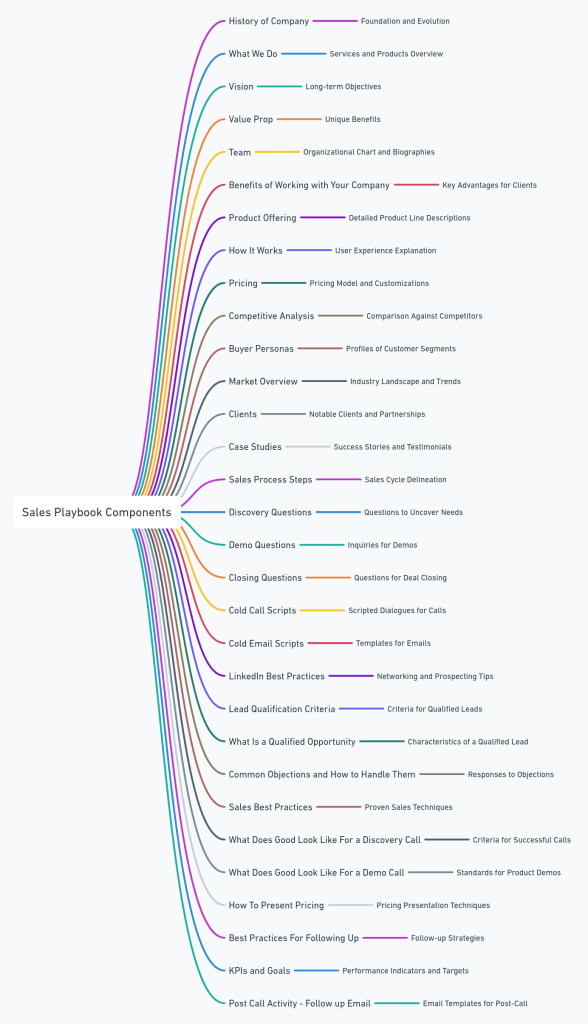
History of Company
The company’s history outlines the foundation and evolution, setting the stage for credibility and experience. This section illustrates the company’s journey, milestones, and growth patterns.
What We Do
A descriptive overview of services and products offered, focusing on specific solutions to customer problems and how the company fulfills market needs.
Vision
The vision statement conveys the company’s long-term objectives, driving home its dedication towards impacting the industry and the target market.
Value Prop
A robust value proposition underscores unique benefits over competitors. It should be clearly articulated to resonate with potential buyers.
Team
An organizational chart of the sales team highlights its structure. Biographies and roles impart personal touchpoints and establish expertise.
Benefits of Working with Your Company
This subsection outlines key advantages for clients choosing your services, from superior customer support to innovative product features.
Product Offering
A detailed enumeration of the product line with succinct descriptions of each item. Highlighting uses and features can distinguish offerings in the marketplace.
How It Works
A clear explanation of how products or services work, narrating the user experience and the ease of integration or deployment.
Pricing
The pricing model should be clearly defined with possible customizations. Transparency in cost structures aids in building trust with prospects.
Competitive Analysis
A tabular comparison against key competitors, showcasing strengths and strategic positioning. This analysis helps identify opportunities for differentiation. This may include sales battlecards.
Buyer Personas
Profiles of ideal customer segments help understand their desires and pain points. Each persona includes demographic details, behavioral attributes, and purchasing motivations.
Market Overview
An overview of the industry landscape, including trends, market size, and growth projections. This knowledge aids in tailoring sales strategies.
Clients
Listing notable clients and partnerships validates credibility and can serve as social proof to prospects.
Case Studies
Success stories and testimonials that demonstrate how the product or service solved specific customer challenges.
Sales Process Steps
A delineation of the sales cycle, from prospecting to closing, including each key touchpoint and expected actions.
Discovery Questions
Crafted questions aimed to uncover a prospect’s needs, challenges, and objectives.
Demo Questions
Tailored inquiries designed to engage prospects during demos and to elicit feedback.
Closing Questions
Strategically framed questions to assist in sealing deals and confirming the prospect’s commitment.
Cold Call Scripts
Scripted dialogues for initial calls that set the stage for effective engagement.
Cold Email Scripts
Templates for cold emails that capture attention and prompt action from recipients.
LinkedIn Best Practices
Tips for leveraging LinkedIn for prospecting and networking. This includes profile optimization and outreach strategies.
Lead Qualification Criteria
Criteria that define a qualified lead, ensuring focus on prospects with genuine interest and need for the product.
What Is a Qualified Opportunity
Characteristics and signals that distinguish a qualified opportunity from a standard lead.
Common Objections and How to Handle Them
Identification of potential objections with ready-to-use responses to handle each scenario adeptly.
Sales Best Practices
A list of proven sales techniques that increase efficiency and effectiveness.
Sales Plays
Whatever the steps need to be taken for various sales scenarios.
What Does Good Look Like For a Discovery Call
Criteria and checkpoints that define a successful discovery call with potential clients.
What Does Good Look Like For a Demo Call
Standards for a compelling product demo that engages and interests prospects.
How To Present Pricing
Techniques to present pricing options in a clear and persuasive manner, ensuring transparency and alignment with value.
Best Practices For Following Up
Strategies for timely and effective follow-up to maintain momentum with prospects.
KPIs and Goals
Key performance indicators and sales targets to enable performance tracking and objective assessments.
Post Call Activity – Follow up Email
Templates for follow-up emails post-call that reinforce messages and maintain engagement with the prospect.
FAQs
The most common questions that are asked, with clear answers.
How Can a Sales Playbook Enhance the Effectiveness of a B2B Sales Strategy?
A sales playbook is a comprehensive document that dictates a sales team’s approach to engaging and converting prospects into customers. It serves as a guide for sales reps, outlining best practices, sales methodologies, and sales plays to optimize their efforts.
Best Practices
Sales playbooks encapsulate best practices which streamline the sales process. They help in creating a standardized approach that can be replicated across the sales team, ensuring consistency and increasing the probability of success.
- Consistent Messaging: A playbook ensures that all sales reps convey a uniform value proposition and brand message, which can significantly impact how the target market perceives a company’s products or services.
- Sales Enablement: Sales enablement is a key component of a playbook. It involves equipping reps with the right tools, resources, and skills to engage effectively with B2B buyers.
- Sales Methodology: It establishes a well-defined sales methodology, incorporating stages from lead generation to closing a deal. This methodology promotes a clear understanding of each phase within the sales cycle, enabling sales reps to maneuver through the sales process skillfully.
- Sales Training: The playbook offers aid in sales training, consolidating the learning process and ensuring that new hires quickly adapt to the organization’s sales culture.
By integrating these elements into a sales playbook, B2B organizations empower their sales teams. Equipped with a well-structured playbook, sales reps can approach the market confidently, efficiently adapting their strategies based on the playbook’s guidance. The playbook is instrumental in elevating the effectiveness of a B2B sales strategy, as it fuels a consistent, methodical, and strategic approach to selling.
Download Sales Playbook Template and Example
Who Should Be Involved in the Creation of a Sales Playbook?
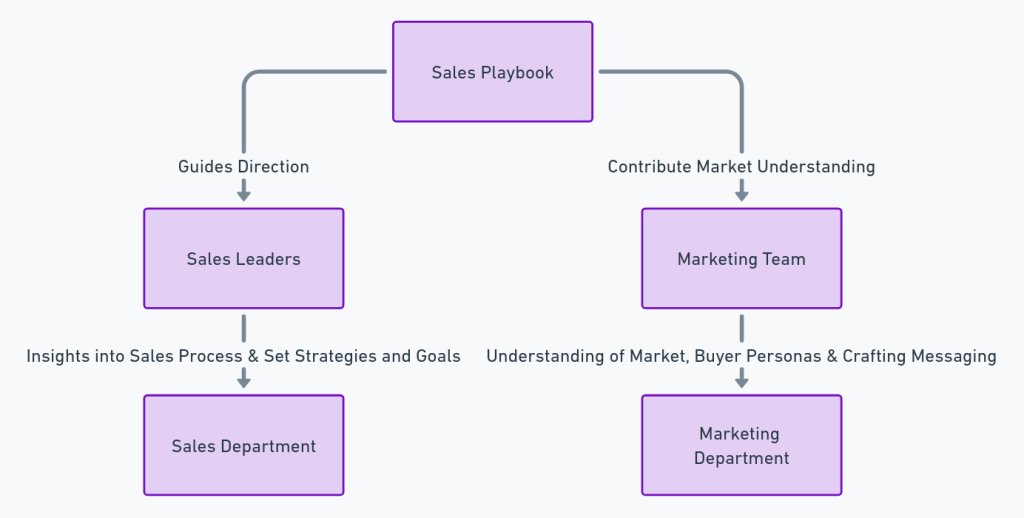
The development of a sales playbook should be a collaborative endeavor that taps into the expertise of multiple stakeholders within an organization. Individuals from different departments bring diverse perspectives and skills, ensuring the playbook is comprehensive and effective.
- Sales Leaders: They provide insights into the sales process and set the overall strategies and goals. Their leadership and vision guide the playbook’s direction.
- Marketing Team: These professionals contribute an understanding of the market, buyer personas, and the customer journey. They craft messaging and help align sales strategies with marketing campaigns.
- HR (Human Resources): Responsible for introducing the sales playbook during onboarding, HR ensures that the playbook complies with company policies and helps in outlining roles and responsibilities.
- Subject Matter Experts (SMEs): SMEs lend technical and product-specific knowledge that is essential for creating accurate content that sales teams can use to address customer queries effectively.
A well-structured organizational chart can be employed to define the hierarchy of involvement and streamline the collaboration process, elucidating how each participant contributes to the playbook’s creation. Below is an example chart outlining roles and responsibilities:
| Role | Responsibilities |
|---|---|
| Sales Leaders | Define sales strategies, oversee playbook structure and content |
| Marketing Team | Provide market insights, create alignment with brand messaging |
| HR | Align playbook with company policy, manage distribution |
| Subject Matter Experts | Ensure technical accuracy, contribute product knowledge |
In third-person perspective, it can be stated that their participation ensures the playbook is not only a practical sales tool but also reflects the company’s brand and operational standards. Each entity plays a critical role in building a playbook that resonates with the sales team and supports them in achieving sales excellence.
How Do You Get Your Salespeople to Use a Playbook?
Ensuring salespeople effectively utilize a sales playbook involves a blend of motivation, comprehensive training, and continuous coaching. Sales managers should first clearly communicate the benefits of using the playbook, highlighting how it can streamline processes and improve sales outcomes, thus motivating their team to embrace this tool.
Training sessions are essential for familiarizing salespeople with the playbook contents. These sessions should be interactive, allowing for a thorough understanding of the different scenarios presented in the playbook. To further reinforce training, incorporating role-playing exercises can help salespeople apply the playbook strategies in real-life sales situations.
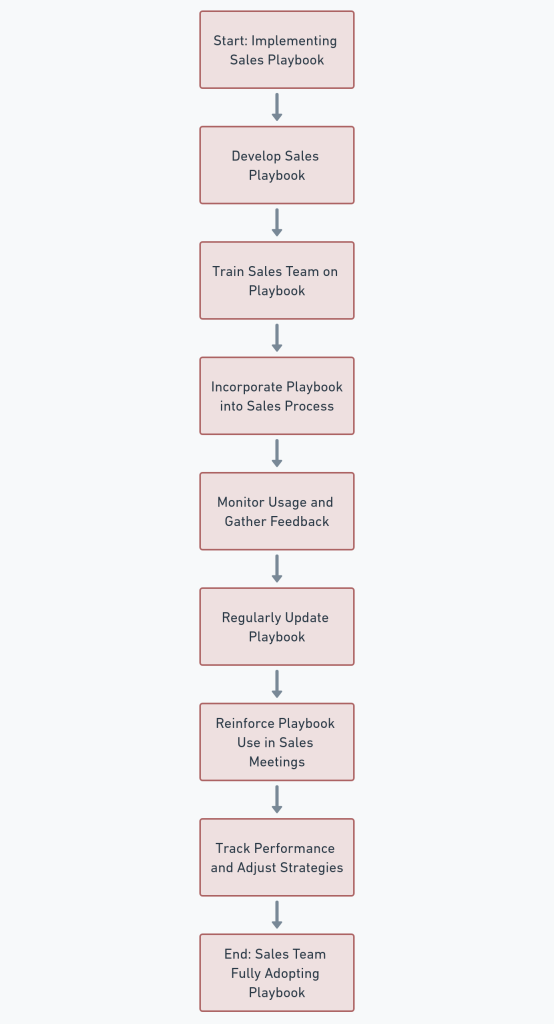
Coaching sessions serve to provide ongoing support and clarification. Sales managers should offer feedback based on actual sales encounters, suggesting improvements and acknowledging successful applications of the playbook strategies.
To maximize engagement with the sales playbook, sales enablement materials should be easily accessible and user-friendly. This includes:
- Checklists
- Case studies
- Scripts and templates
Regularly updating these materials ensures they remain relevant and valuable to the sales team.
Soliciting feedback from the sales team is crucial for two reasons: it shows that their input is valued, and it allows managers to make necessary adjustments to the playbook. Recognizing individuals who effectively use the playbook can motivate others to follow suit.
Ultimately, regular engagement with the playbook should be part of the sales culture. Using a system of accountability ensures that the playbook remains a central tool in the sales process.
What Internal Content Should Be in the Sales Playbook?
A comprehensive sales playbook consolidates essential resources and documents that empower sales teams with the knowledge and tools they need for every stage of the sales process.
Training Materials
Training materials are crucial for development and onboarding new sales representatives. They should include:
- Sales Methodologies: Outlines of established procedures and sales strategies.
- Product Knowledge: Detailed information on the product line, benefits, and value proposition.
- Scripts and Role-Play Scenarios: For practicing sales pitches and handling objections.
Sales Battle Cards
Sales battle cards equip sales teams with concise, strategically designed information:
- Sales Plays and Messaging: Key sales messaging tailored to different leads or situations.
- Objection Handling: Guidance on how to counter common objections with clear, persuasive responses.
Sales Decks
Sales decks provide a visual aid for sales presentations and typically contain:
- Company Overview: Brief insight into the company’s story, mission, and values.
- Product Benefits and Value Proposition: Engaging presentation of product advantages tied to customer needs.
Sales Enablement Content
Sales enablement content refers to materials that support sales team efficiency:
- Email Templates and Call Scripts: Standardized communication aids to streamline outreach.
- Sales Workflows and Processes: Step-by-step workflows for consistent sales execution.
Competitor Insights
Competitor insights offer strategic information about market positioning and rival offerings:
- Market Analysis and Industry Benchmarks: Data-driven insights evaluating market trends and benchmarks.
- Competitor Strategies: Profiles detailing competitors’ products, strategies, and perceived strengths and weaknesses.
How Does a Sales Playbook Contribute to the Overall Sales Process and Team Performance?
A sales playbook serves as a comprehensive guide that outlines the sales process, providing a clear framework for the sales team to follow. It ensures consistent application of best practices across the team, which can lead to improved efficiency and effectiveness. Sales playbooks usually delineate each stage of the sales cycle, which helps salespeople understand the steps required to move a prospect from initial contact to a closed sale.
Within a sales playbook, sales goals and revenue targets are often clearly defined. Performance metrics and KPIs (Key Performance Indicators) are included as benchmarks to measure individual and team achievements against organizational objectives. This structured approach enables sales teams to identify areas of success and recognize where improvements are needed.
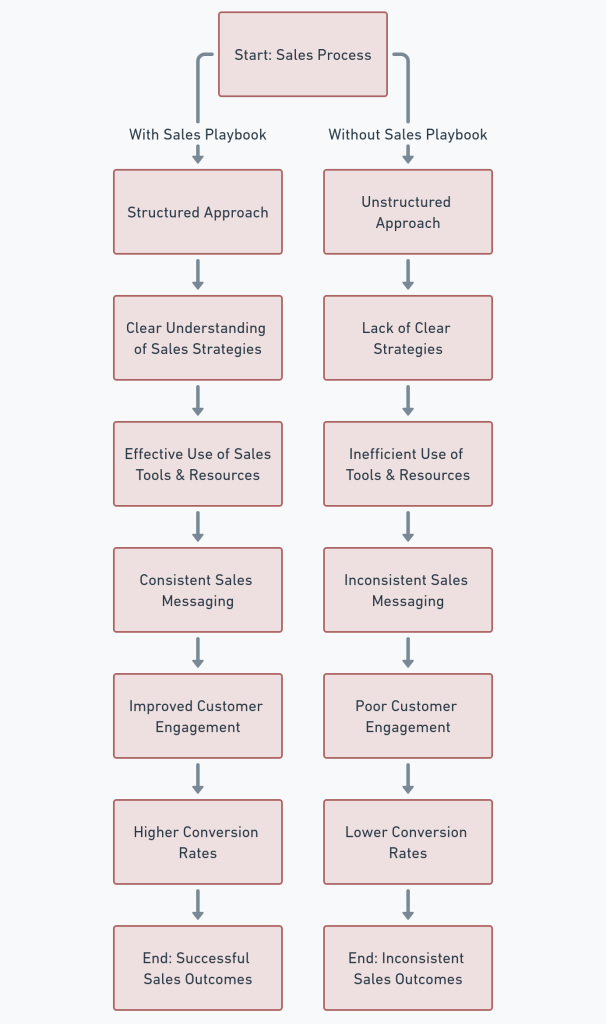
By detailing strategies and tactics, a sales playbook provides sales representatives with the necessary tools to navigate complex sales scenarios. This can include scripts for sales calls, email templates, and guidelines on how to handle objections, ensuring that team members are well-prepared for various interactions with prospects.
The use of a sales playbook typically contributes to:
- A more streamlined sales process, reducing time spent on ineffective methods.
- Enhanced alignment across the sales team, leading to a unified approach to engaging with prospects.
- Continuous improvement through regular updates to the playbook, incorporating new techniques and responses to market changes.
In summary, a sales playbook is integral to standardizing procedures, measuring performance, and achieving sales targets within a sales organization. Its role in providing clear direction and resources supports a confident and knowledgeable sales team capable of meeting their objectives.
Common Sales Playbook Mistakes
Many sales organizations construct a playbook to guide their team but overlook critical aspects that can lead to suboptimal results. One prevalent mistake is failing to demonstrate value effectively. Sales teams often focus on product features rather than how these features solve a customer’s problem. This approach can result in a disconnect, as the customer may not see the personal or economic benefit of the product.
Another area where sales playbooks fall short is in persona alignment. Not tailoring sales strategies to align with the various customer personas is a common oversight. Each customer type has distinct needs and pain points, and a “one-size-fits-all” approach does not resonate well with diverse audiences.
Recognizing and addressing friction points is crucial, yet frequently neglected. Sales processes should be examined for any steps that cause unnecessary complexity or delays for the customer, which can deter the final decision.
Moreover, misunderstandings or miscommunication) can derail a sales process. Clear, consistent communication both internally among team members and externally with customers is essential for the success of any sales strategy.
Lastly, a vision mismatch can be detrimental. The sales playbook should reflect the overarching vision of the company and integrate with broader marketing and operational strategies. When these elements do not align, the disjointed approach can confuse customers and staff, leading to reduced effectiveness.
To summarize, sales playbooks can fail due to a lack of demonstrated value, improper persona alignment, unaddressed friction points, miscommunication, and vision misalignment. A carefully crafted sales playbook avoids these pitfalls, leading to better sales performance.
Frequently Asked Questions
The Frequently Asked Questions section addresses common inquiries regarding the implementation and optimization of sales playbooks, providing concise, expert insights to enhance sales operations and strategy.
How can a sales playbook improve a sales team’s efficiency and effectiveness?
A sales playbook streamlines the sales process by providing a structured approach that includes best practices, strategies, and tools. This ensures sales representatives spend less time guessing and more time engaging with prospects effectively.
What are the key components to include in a well-structured sales playbook?
Essential components of a sales playbook include target customer profiles, sales processes, messaging scripts, objection handling guidelines, and case studies. Including actionable content empowers sales teams to execute strategies with precision.
In what ways can a sales playbook be tailored to fit B2B sales strategies?
A B2B sales playbook should focus on long sales cycles, relationship building, and complex decision-making processes. It often incorporates detailed prospecting techniques, stakeholder management strategies, and a clear understanding of the buyer’s journey.
How often should a sales playbook be updated to remain relevant and useful?
Sales playbooks should be reviewed quarterly or biannually to incorporate new insights, market trends, and feedback from sales interactions. Regular updates ensure the playbook adapts to changing market dynamics and remains a valuable resource.
What are some best practices for training sales teams on a new sales playbook?
Best practices include interactive training sessions, role-playing scenarios, and continuous support. Ensuring sales teams understand the playbook’s value and are proficient in applying its guidelines leads to better adoption and performance.
Can you recommend strategies for creating a high-impact sales playbook for launching new products?
For new product launches, a sales playbook should highlight unique value propositions, competitive advantages, and tailored go-to-market strategies. Immediate training and incorporating feedback from early sales experiences are vital for evolving the playbook.

